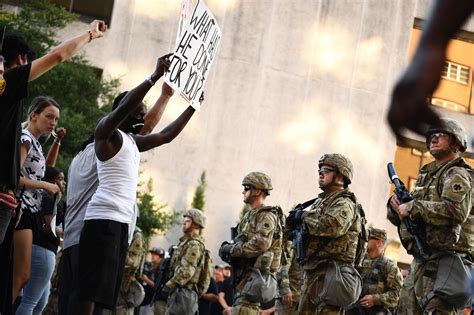
A white protester’s impassioned speech challenging the morality of Immigration and Customs Enforcement (ICE) and its separation of families at the border gained widespread attention after a video of the confrontation went viral, showing members of the National Guard appearing to listen intently. The incident occurred during ongoing protests against ICE policies, sparking renewed debate over immigration enforcement and the role of law enforcement agencies.
A video circulating online shows a white protester delivering a powerful and emotional speech directly to National Guard members, questioning the ethics and humanity of ICE’s practices, particularly the separation of families at the U.S.-Mexico border. The confrontation, captured on video, has garnered significant attention and sparked widespread discussion about immigration policies and the role of law enforcement.
The protester, whose identity remains undisclosed, directly addressed the National Guard troops deployed in support of ICE, challenging them to consider the moral implications of their involvement. The video shows the protester speaking with conviction, articulating concerns about the impact of ICE policies on immigrant families and children.
“Are you a human being?” the protester asks in the video. “Are you able to discern right from wrong? Because if you are, I implore you, please, think about what you’re doing. Look at who you’re hurting. You’re tearing apart families.”
The video shows the National Guard members listening attentively, maintaining a stoic demeanor throughout the protester’s address. The contrast between the protester’s impassioned plea and the soldiers’ silent response has become a focal point of discussion, prompting viewers to interpret their reaction in various ways.
The confrontation occurred amid escalating protests against ICE facilities and policies across the country. Demonstrators have been voicing concerns about the treatment of immigrants, particularly the separation of families, detention conditions, and deportation practices. The protests have drawn a diverse range of participants, including activists, community organizers, and concerned citizens.
The viral video has amplified the debate surrounding immigration enforcement, with many using it as evidence of the moral complexities faced by those involved in carrying out controversial policies. Supporters of the protester’s actions have praised their courage and conviction, while critics have questioned the effectiveness and appropriateness of confronting law enforcement personnel in such a manner.
Context of Immigration Enforcement and Protests
The debate over immigration enforcement has intensified in recent years, driven by policy changes, increased border security measures, and heightened public awareness of the challenges faced by immigrant communities. ICE, as the primary agency responsible for enforcing immigration laws, has become a frequent target of criticism and protest.
The separation of families at the border, a policy implemented during the Trump administration, drew widespread condemnation from human rights organizations, political leaders, and the general public. The policy resulted in thousands of children being separated from their parents, with many families facing significant challenges in reuniting.
In response to these policies, protests have erupted across the country, targeting ICE facilities, government buildings, and public spaces. Demonstrators have demanded an end to family separations, improved conditions for detained immigrants, and a pathway to citizenship for undocumented individuals.
The protests have involved a variety of tactics, including marches, rallies, sit-ins, and acts of civil disobedience. Activists have also utilized social media and online platforms to raise awareness, mobilize support, and share stories of affected individuals and families.
Ethical Dilemmas and the Role of Law Enforcement
The confrontation between the protester and the National Guard members highlights the ethical dilemmas faced by law enforcement personnel tasked with enforcing controversial policies. While obligated to follow orders and uphold the law, officers also have a personal responsibility to consider the moral implications of their actions.
The National Guard, in particular, occupies a unique position, as its members are often drawn from local communities and may have personal connections to the individuals and families affected by immigration policies. This can create internal conflicts and raise questions about the extent to which soldiers should comply with orders that they believe are unjust or immoral.
The video of the protester’s speech has prompted discussions about the importance of critical thinking and ethical decision-making within law enforcement agencies. Some commentators have argued that officers should be encouraged to question the legality and morality of the policies they are asked to enforce, while others maintain that strict adherence to the chain of command is essential for maintaining order and security.
Reactions to the Video and its Impact
The video of the confrontation has elicited a wide range of reactions, reflecting the diverse perspectives and opinions surrounding immigration enforcement. Supporters of the protester have praised their courage and conviction, viewing the speech as a powerful indictment of ICE policies and a call for moral accountability.
Critics, on the other hand, have accused the protester of being disrespectful to law enforcement personnel and attempting to intimidate them. Some have argued that the protester’s actions were counterproductive, potentially alienating those who may be sympathetic to the cause.
Regardless of individual perspectives, the video has undoubtedly amplified the debate over immigration enforcement and brought renewed attention to the ethical complexities faced by those involved in carrying out these policies. It has also served as a reminder of the power of individual voices to challenge authority and spark dialogue on important social issues.
The long-term impact of the video remains to be seen, but it has already contributed to a heightened awareness of the human consequences of immigration policies and the moral responsibilities of those who enforce them. It is likely to continue to be a subject of discussion and debate as the immigration debate evolves.
The incident also underscores the tensions between federal mandates and local sentiments. While the National Guard is often deployed under federal authority to assist ICE, their presence can be perceived differently within the communities they serve. This dichotomy often leads to public scrutiny and challenges the narrative of unified national security.
Furthermore, the protester’s appeal to the “humanity” of the National Guard members taps into a broader conversation about the militarization of immigration enforcement. Critics argue that the use of military personnel and tactics in civilian law enforcement contexts can normalize excessive force and erode trust between communities and authorities.
The legal framework surrounding immigration enforcement also plays a crucial role in shaping public perception and sparking protests. Immigration laws are complex and subject to interpretation, leading to disagreements about the scope and limits of ICE’s authority. Court decisions and legal challenges often serve as catalysts for protests and activism, as advocates seek to hold the government accountable for its actions.
Analysis of the Protester’s Rhetoric
The protester’s speech employs a variety of rhetorical devices to persuade and influence the National Guard members. The use of direct questions, such as “Are you a human being?” is intended to appeal to their sense of morality and empathy. By framing the issue in terms of right and wrong, the protester seeks to challenge the soldiers’ assumptions and encourage them to question their role in enforcing ICE policies.
The protester also uses vivid and emotional language to describe the impact of ICE policies on immigrant families. By highlighting the suffering of children and the pain of separation, the protester aims to evoke feelings of compassion and outrage. This emotional appeal is designed to create a sense of urgency and motivate the soldiers to take action.
In addition, the protester employs a strategy of personal connection, speaking directly to the soldiers as individuals rather than as representatives of the government. This approach is intended to humanize the interaction and create a sense of shared responsibility. By appealing to their personal values and beliefs, the protester hopes to persuade the soldiers to reconsider their support for ICE policies.
The National Guard’s Perspective
While the video captures the protester’s impassioned speech, it provides limited insight into the National Guard members’ perspectives. It is possible that the soldiers were instructed to maintain a neutral demeanor and avoid engaging with protesters. However, their silence could also reflect a range of emotions and beliefs, including sympathy for the protesters’ cause, uncertainty about the legality or morality of ICE policies, or a commitment to upholding their duty as soldiers.
The National Guard members may also be constrained by their oath of enlistment, which requires them to obey lawful orders. Questioning or refusing to carry out orders could have serious consequences, including disciplinary action or legal repercussions. This can create a difficult dilemma for soldiers who may have personal reservations about the policies they are asked to enforce.
Furthermore, the National Guard members may have limited knowledge of the specific details of ICE policies or the experiences of immigrant families. Their understanding of the issue may be shaped by official narratives and media coverage, which may not fully reflect the complexities and nuances of the situation.
Moving Forward: Dialogue and Policy Reform
The confrontation between the protester and the National Guard members underscores the need for continued dialogue and policy reform on immigration enforcement. It is essential to create spaces for open and honest conversations about the ethical implications of these policies and the impact on affected communities.
Lawmakers and policymakers should consider comprehensive immigration reform that addresses the root causes of migration, provides a pathway to citizenship for undocumented individuals, and ensures humane treatment for all immigrants. This should include increased oversight and accountability for ICE and other law enforcement agencies involved in immigration enforcement.
In addition, efforts should be made to educate law enforcement personnel about the complexities of immigration law and the human consequences of their actions. This could include training programs that promote critical thinking, ethical decision-making, and cultural sensitivity.
Finally, it is crucial to amplify the voices of immigrant communities and ensure that their experiences are heard and understood. This can be achieved through community forums, storytelling initiatives, and advocacy campaigns. By working together, we can create a more just and humane immigration system that respects the rights and dignity of all individuals.
The Role of Social Media in Amplifying the Message
The rapid spread of the video on social media platforms like Twitter, Facebook, and YouTube highlights the power of these channels to amplify messages and shape public opinion. The video’s virality allowed the protester’s message to reach a global audience, sparking discussions and debates that extended far beyond the immediate context of the protest.
Social media also provides a platform for individuals and organizations to share their perspectives and experiences, challenge dominant narratives, and mobilize support for social and political causes. In the case of immigration enforcement, social media has been used to raise awareness about the human consequences of these policies, document abuses, and organize protests and advocacy campaigns.
However, social media also has its limitations and potential drawbacks. The spread of misinformation and disinformation can undermine trust in institutions and create division and polarization. It is essential to critically evaluate information and be aware of the potential for manipulation and bias.
Despite these challenges, social media remains a powerful tool for amplifying messages, fostering dialogue, and promoting social change. By using these platforms strategically and responsibly, individuals and organizations can contribute to a more informed and engaged public discourse.
The Broader Implications for Civil Disobedience
The protester’s actions raise important questions about the role of civil disobedience in a democratic society. Civil disobedience, defined as the intentional violation of laws or regulations for the purpose of protesting injustice, has a long and storied history in the United States and around the world.
From the Boston Tea Party to the Civil Rights Movement, civil disobedience has been used to challenge unjust laws and policies, raise awareness about social issues, and promote social change. However, civil disobedience also carries risks and potential consequences, including arrest, prosecution, and social stigma.
The effectiveness of civil disobedience depends on a variety of factors, including the nature of the issue being protested, the tactics used by protesters, and the response of authorities. Nonviolent civil disobedience, in particular, has been shown to be an effective strategy for achieving social and political change.
The protester’s speech to the National Guard members can be seen as an act of civil disobedience, as it involved directly confronting law enforcement personnel and challenging their authority. Whether this action will ultimately be effective in promoting change remains to be seen, but it has undoubtedly sparked a conversation about the ethical implications of immigration enforcement and the role of individuals in challenging unjust policies.
The Intersection of Race and Immigration
The fact that the protester is white adds another layer of complexity to the situation. In the context of immigration enforcement, race plays a significant role in shaping public perceptions and policy outcomes. Studies have shown that racial bias can influence law enforcement decisions, leading to disproportionate targeting of Latino and other minority communities.
The protester’s race may also influence the way their message is received by the public and by law enforcement personnel. Some may argue that a white protester’s voice is more likely to be heard and respected than that of a person of color. Others may criticize the protester for appropriating the struggles of immigrant communities or for failing to acknowledge the role of white privilege in perpetuating systemic inequalities.
Regardless of individual perspectives, it is important to acknowledge the intersection of race and immigration and to address the systemic biases that contribute to unfair and discriminatory outcomes. This requires a commitment to racial justice and a willingness to challenge the structures and institutions that perpetuate inequality.
FAQ Section:
1. What exactly happened in the video featuring the protester and the National Guard?
The video shows a white protester delivering an impassioned speech directly to National Guard members deployed in support of ICE. The protester challenges the soldiers to consider the moral implications of their involvement in ICE policies, particularly the separation of families at the U.S.-Mexico border. The National Guard members listen attentively, maintaining a stoic demeanor throughout the address. The video has sparked widespread discussion about immigration policies, the role of law enforcement, and ethical responsibilities.
2. Why are people protesting against ICE?
People are protesting against ICE (Immigration and Customs Enforcement) due to concerns over its policies and practices, particularly the separation of families at the border, the conditions in ICE detention facilities, and the agency’s deportation practices. Critics argue that ICE’s actions violate human rights, disproportionately affect immigrant communities, and contribute to a climate of fear and discrimination. Protesters demand an end to family separations, improved conditions for detained immigrants, and a pathway to citizenship for undocumented individuals.
3. What is the role of the National Guard in relation to ICE?
The National Guard is sometimes deployed to support ICE in border security and immigration enforcement efforts. This support can include providing logistical assistance, assisting with surveillance, and helping to manage detention facilities. The deployment of the National Guard in these roles has been controversial, with critics arguing that it militarizes immigration enforcement and blurs the lines between military and civilian law enforcement functions.
4. What are the ethical dilemmas faced by law enforcement personnel in enforcing immigration laws?
Law enforcement personnel tasked with enforcing immigration laws often face ethical dilemmas. They are obligated to follow orders and uphold the law, but they may also have personal reservations about the policies they are asked to enforce. This can create internal conflicts, particularly when officers believe that certain policies are unjust or immoral. Some commentators argue that officers should be encouraged to question the legality and morality of the policies they are asked to enforce, while others maintain that strict adherence to the chain of command is essential.
5. How has social media amplified the debate over immigration enforcement?
Social media has played a significant role in amplifying the debate over immigration enforcement. Platforms like Twitter, Facebook, and YouTube have allowed individuals and organizations to share information, organize protests, and raise awareness about the human consequences of immigration policies. The rapid spread of videos, images, and stories on social media has helped to shape public opinion and create a sense of urgency around the issue. However, social media also has its limitations, including the spread of misinformation and the potential for bias and manipulation.









